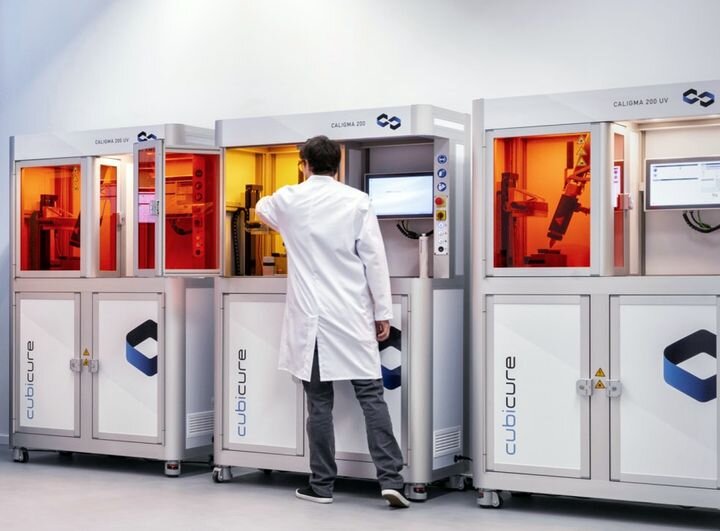![Operator working on Cubicure 3D printers [Source: Cubicure]](https://fabbaloo.com/wp-content/uploads/2020/05/image-asset_img_5eb0508fedc14.jpg)
Cubicure has developed an interesting approach to resin 3D printing.
Resin 3D printing is rapidly becoming one of the most popular 3D printing methods, with several different specific processes including SLA, stereolithography, DLP and others. Most of these approaches have a notable challenge: viscosity.
3D Printer Resin Flow Challenges
While photopolymer resins solidify when exposed to an energetic light source in a similar way, there is a challenge when changing layers. When the 3D printer’s motion system moves the just-completed layer to a new height, fresh resin must flow in to occupy that space and prepare for creation of the subsequent layer.
This is sometimes a difficult process, as the resin must flow a substantial distance in some geometries. Imagine 3D printing a brick: in each layer the resin must flow across the entire cross-section of the brick.
Now imagine 3D printing a more sparse 3D models, say the classic Eiffel Tower. The tower has hardly any large contiguous areas and on a layer-by-layer basis, is mostly a series of dots representing the cross section of the structure’s metal grid. In this scenario, the resin can very quickly flow across those small areas.
But 3D printers must be designed to handle all cases, and so even though it’s easier to 3D print sparse 3D models, they must account for “brick” scenarios, too. Most systems thus allow for a standard time delay to permit maximum flow of resin. However, that slows 3D printing operations.
Viscous 3D Printing Resin
To overcome this, many 3D printer configurations use resin that flows more easily, in other words less viscous resin. If resin were equal viscosity to water, then this wouldn’t be a problem. But resin is typically thick, and that’s because of the additives mixed into the fluid.
These additives are often what makes the resin have the advertised engineering properties. It’s easy to add them, so long as they don’t increase the viscosity of the resin very much. If they do, then printing could be slowed even more.
This results is constraints on the additives used in 3D printing resins, and consequently constraints on the engineering properties of the objects 3D printed with those resins. That’s why you often find resin prints are more fragile than those made with other 3D printing processes.
Cubicure Hot Lithography
That’s where Cubicure comes in. The Austrian company has been working on what they call “hot lithography”. They explain:
“Cubicure’s newly developed photopolymers are exceedingly tough and have a high dimensional stability under heat. Those properties can be obtained through highly viscous and sticky raw materials, which cannot be processed in commercial SLA machine until now. Out of this, Cubicure developed its own additive manufacturing process, Hot Lithography, for the processing of those poorly flowable material systems.”
Caligma 200 3D Printer
To implement this approach, the company has also developed a 3D printer, the Caligma 200. They explain how it works:
”With its patented Hot Lithography technology, Cubicure’s Caligma 200 production plant enables the easy and professional processing of high performance photopolymers. The core of this technology is a specifically developed heating and coating mechanism which can process resins and pastes of the highest viscosity (at processing temperatures up to 120°C) with highest reliability and precision. Machine design focused on the combination of flexibility of usable materials and the greatest possible process safety.”
Thus it appears they are able to use higher viscosity resins, which presumably have a wider range of additives and engineering properties.
Cubicure explained that the Caligma 200 operates much like a DLP 3D printer, except that instead of having a vat of resin they use a thin film. The system deposits a thin layer of viscous resin on a carrier plate, where the temperature is precisely managed.
It’s an interesting approach to resin 3D printing, where Cubicure is attempting to add good mechanical properties to the already great resolution and surface quality of resin 3D printing.
Via Cubicure

